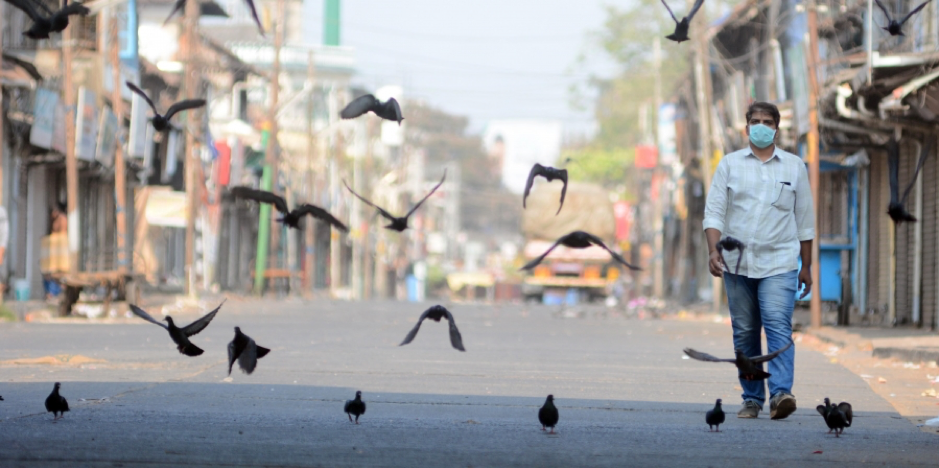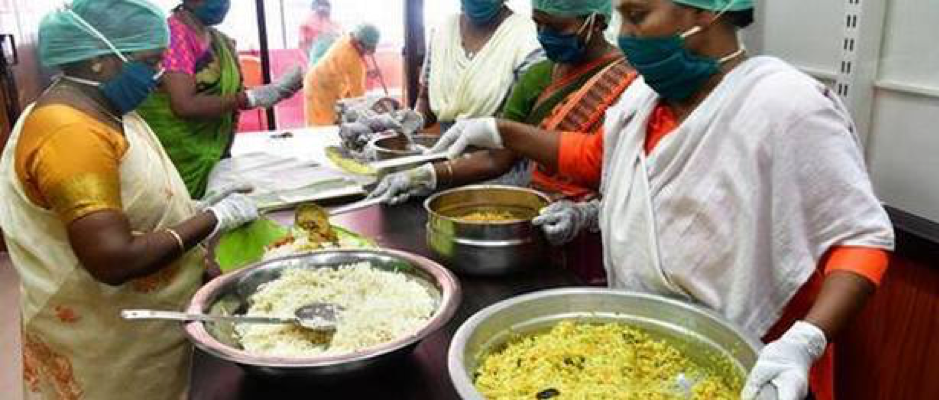
The novel coronavirus poses a serious threat to the very foundations of modern civilisations. The speed at which the infectious disease spread and the lack of a proper scientific remedy to curb it resulted in diverse responses and repercussions around the world. Even the wealthy, prosperous first world nations have had a little success in containing the pandemic. With their hospitals overwhelmed with patients and death toll increasing dramatically, the chronic incompetence of states were exposed.

Although it is populated with 36 million – almost as same as Canada – its death tolls are single in numbers and has about 1 case per 100,000 of its population[1]. Kerala has successfully addressed the pandemic so far and has geared up its mechanisms to handle the upcoming and unprecedented challenges.
1
Glimpses From the Past
回顾过去
Victor M Fic, Czech political scientist and orientalist called Kerala the ‘Yenan of India’, in his book published in 1970 [2]. The birth place of Communist Party of India in 1939, Kerala became a strong hold of left politics in the coming decades. Overcoming two centuries of colonization and exploitation, India became independent in1947 and chose to follow the democratic system of governance. Communist parties also went into the election foray and won the first election in the newly born state of Kerala in 1957, and became the world’s first democratically elected communist government[3]. Since the 1950s, the communists have held power for more than 30 years forming different governments, including the present Left Democratic Front since 2016.

在左翼运动的支持下,这些政府实施了激进彻底的改革,改变了喀拉拉邦的社会结构。它们与进步运动的共生关系为社会带来了翻天覆地的变化。扫盲运动、公共图书馆运动、科普运动等皆得到了历届政府的鼓励和重视。喀拉拉曾为后殖民印度最贫穷的邦之一,而那些具有改革倾向的政策和在健康、教育与社会福利计划领域内的重大投资使其一跃成为印度识字率最高(93.9%)、平均寿命最高(77年)和人类发展指数得分最高(2015年得分0.712)的邦。此外,该邦亦在新生儿死亡率[译者注:此处应指喀拉拉邦新生儿死亡率为全印度最低]、出生免疫率与基层护理机构专家资源方面领跑印度。它也因其遍布全球富裕国家医院的高水平医护人员而闻名遐迩。
 96-year-old Karthiyani Amma (left) who topped Kerala literacy exam.
96-year-old Karthiyani Amma (left) who topped Kerala literacy exam.The state’s exemplary social indicators led to the coinage of ‘Kerala Model’ in the 1970s, to note how a low-income state with high literacy rates and healthy citizens boasted a standard of living comparable to life in the developed nations. In 2018, it earned praise from the World Health Organization for ‘achieving impressive health outcomes at modest incomes compared to the rest of the states in India’[5].
喀拉拉邦各项堪称典范的社会指标促成了“喀拉拉邦模式” (Kerala Model)一词在上世纪70年代的产生。它描述了一个识字率高、公民健康的低收入邦如何成功拥有堪比发达国家的生活水平。2018年,该邦获得了世界卫生组织的赞扬,因其“与印度其他邦相比,在收入不高的情况下取得了令人印象深刻的健康成果”。

(https://www.newindianexpress.com/states/kerala/2020/apr/01/data-geeks-install-kerala-covid-tracker-2124104.html)
It is also noteworthy to mention that, at a time when public health systems around the world were neglected as a consequence of financial crisis of 2008-2009, the left government of Kerala between 2006-2011 revamped the public health care system by allocating special financial assistance[6].
2
Facing a Crisis Together From the Roots
共同面对危机之根本
A number of factors make Kerala more vulnerable to a global pandemic like COVID 19. In terms of its engagement with the world, Kerala is a highly globalised state. It has a considerable number of foreign expats and is a popular destination for international tourists. It is the only state in India with four International airports to its credit. More than 1 million tourists arrive in this coastal state a year, and one sixth of its 36 million citizens are expatriates, and hundreds of its students study in China. On 30th January, a student of the Wuhan Institute of Medical Sciences who had come back home, tested positive for the novel corona virus, the first ever case reported in India. In the coming days, two more cases appeared, all came back from Wuhan.
有许多因素使喀拉拉邦更容易受到像新冠肺炎这样的全球流行病的影响。就同世界的接触而言,喀拉拉是一个高度全球化的邦。该邦有众多外籍人士,亦是国际游客的热门目的地。它是全印度唯一一个拥有四个国际机场的邦。每年有超过100万游客来到沿海的喀拉拉,其3600万公民中有六分之一是外籍人士,也有数百名学生在中国学习。1月30日,武汉医学院的一名学生回国后被测出新冠病毒呈阳性,这是印度报道的首例新冠病毒感染病例。在接下来的几天里又出现了两例,[感染者]均是由武汉返回的。
In the following days, Kerala came up with mass mobilisation, community intervention, and an effective crisis communication to resist the spread of this foreign imported virus. Days before the Indian government decided to take stringent measures, Kerala opted to go for a state-wide lock down and started conducting tests for its foreign returnees and putting them under quarantine and observation.

(https://www.newindianexpress.com/states/kerala/2020/apr/09/covid-19-lockdown-leaves-cancer-patients-in-kerala-distressed--2127616.html)
喀拉拉邦政府遵循了世卫组织建议的早期、“积极”的检测方法,不仅要检测有症状的人,还要检测那些与感染者接触过的人,这使得它做过的检测数量超过了印度任何一个邦。政府开始编制与广泛分发详细的感染者[经过地点的]路线图,用以帮助锁定所有潜在的感染者并对其进行有效观察,从而抑制病毒在社区内的早期传播。


由卫生部发起的“打破链条”运动变得十分流行。该项运动的目的是通过坚持个人卫生和保持社交距离,阻止病毒的人际传播,从而打破感染链条。通过传统媒体和社交媒体,各种提升大众意识的信息与民众参与的活动得到了宣传,并收获了人们的赞赏与合作。
 “打破链条”运动标志
“打破链条”运动标志 “物理距离、社会团结:印度的红色之邦是如何控制住新冠病毒的”---《论坛报》
“物理距离、社会团结:印度的红色之邦是如何控制住新冠病毒的”---《论坛报》 A global pandemic with multitude of socio-cultural and economic dimensions requires much more than mere medical interventions. Thus, preventive measures require community intervention and grassroot mobilisation. With its strong and highly decentralised local administrative institutions, civil society organisations, cooperative societies, youth organisations, and trade unions, Kerala could mobilise its resources from the grassroots towards meeting the crisis. Thousands of volunteers were recruited from the local level to help different departments working to curb the pandemic. Kerala set up an ‘Arogya Sena’ (Health Army) to reach the nook and corner of the state to manage the crisis. These groups prepared hand sanitisers, facemasks and distributed it among the people, and also helped to convert hospitals exclusively for COVID 19 treatments.
涉及众多社会文化与经济层面的全球流行病需要的不仅仅是医疗干预。因此,预防措施需要包含社区介入和基层动员。喀拉拉邦拥有强大且权力高度下放的地方行政机构、公民社会组织、合作社、青年组织和工会,可从基层调动资源,以应对危机。当地招募了数千名志愿者来协助不同部门遏制疫情。喀拉拉邦建立了一支“健康部队”(Arogya Sena),延伸至邦内的各个角落以处理危机。这些组织准备了洗手液和口罩并分发给群众,此外还帮助医院转型成为新冠肺炎专门治疗点。

3
To Leave No One Behind
不落下一个人

Kerala also declared an economic package worth $2.6 billion to fight the pandemic, days before the central government instituted a harsh lockdown that left many states scrambling. The package includes loans to families through the women’s cooperatives, higher allocations for a rural employment guarantee scheme, two months of pension payments to the elderly, free food grains, and restaurants to provide food at subsidised rates. On the other hand, utility payments for water and electricity as well as interest on debt payments will be extended[9].
印度中央政府制定了严厉的封锁措施,使许多邦陷入混乱。在这之前,喀拉拉邦还宣布了一项价值26亿美元的经济计划以抗击疫情。该计划包括通过妇女合作社向家庭提供贷款、提高农村就业保障计划的拨款、向老年人支付两个月的养老金、供应免费粮食,以及令餐馆提供补贴价格的食品。另一方面,水电费与债务利息支付将得到延期。

4
Communication During a Pandemic
疫情下的交流与传播
喀拉拉邦首席部长皮纳拉伊·维贾扬(Pinarayi Vijayan)在每晚的新闻发布会上向公众发表讲话。他给出了关键性的统计数字,并强调了截至目前政府所做的安排、指出了本邦仍需改进的地方、请求群众为抗击新冠疫情提供支持。成千上万的人们粘着电视与手机观看这1小时的节目,结果,它为该电视频道创下了其观众数量的历史新纪录。此外,交流传播已成为优先事项,人们通过社交媒体及纸媒、广播电视获取精确的信息与指导方针。喀拉拉邦卫生部长KK·莎伊拉贾(KK Shailaja)带头作出努力,显示出真正的政治家风度,赢得了人民的信任和爱戴。她的领导才能与组织能力堪称典范,这是对“只有男性才有能力以有效的方式处理危机”这一根深蒂固的厌女主义观念的一个打击。


5
Facets of a Health Crisis
健康危机面面观
当如此规模与严重的全球流行病袭击人类时,它便不再仅仅是一个健康问题,而往往成为对我们的政治制度及其意识形态的效率与价值的考验。

“新冠病毒没有打破体制;它揭露了破碎的体制”
The capitalist societies, which ignored the scale of the problem and decided to run the economy instead of implementing stringent measures paid for their ignorance and choices of priorities. The global neoliberal proponents advocate for a state with minimal powers and bet on the efficiency of the private sector by criticising the government expenditure on public social welfares. For them, government expenditure on public health is considered as a wastage of resources. The COVID 19 pandemic exposes the myth of market serving the needs of a society. The economically less advantaged provinces and nations has shown how effective it is to allocate resources and mobilize masses to achieve social goals. Places like Kerala, where political parties are active with the idea of socialism did prioritise community over individualism, thus summon masses and showed the spirit of volunteerism and collectivism to fight against the virus. Social solidarity, shared interests and a sense of responsibility along with a firm public health care system allows them to confront disasters in a way much better than the wealthy capitalist governments with massive resources.
资本主义社会忽视了该问题的规模,决定运行经济而非实行严格的管制措施。它们为自己的愚昧无知与优先选择付出了代价。全球新自由主义支持者主张建立一个权力最小化的国家,批评政府对公共社会福利的支出,押注于私营部门的效率。对他们来说,政府在公共卫生方面的花费被认为是对资源的浪费。这场新冠肺炎流行病揭露了“市场服务社会需求”这一谬见。经济条件较差的省份和国家已展示了如何通过有效分配资源与动员群众来实现社会目标。像喀拉拉邦这样的地方,政党的社会主义思想活跃,将集体置于个体之上,召集大众共同抗议,体现了志愿服务主义与集体主义精神。社会的团结、共同的利益与责任感,以及坚实的公共医疗体系使他们在应对灾难方面比资源充沛、富裕的资本主义政府做得更好。


作者:Vishnu Karuthodi
编译:杨以轩
*文章原标题:脱颖而出的印度喀拉拉邦抗疫模式 | When the Kerala Model Meets the Pandemic
References|参考文献:
[1]Hollingsworth, J. (2020, May 13). The way these Indian states handled coronavirus shows where you live matters. CNN. Retrieved fromhttps://edition.cnn.com/2020/05/12/asia/india-coronavirus-kerala-flatten-curve-intl-hnk/index.html
[2]Fic, V. M. (1970). Kerala, Yenan of India: rise of Communist power, 1937-1969. Bombay: Nachiketa Publications.
[3]Lal, A. (2017, April 5). On 60th anniversary of EMS’s govt, some lessons. The Indian EXPRESS. Retrieved fromhttps://indianexpress.com/article/explained/in-fact-on-60th-anniversary-of-emss-govt-some-lessons-4599878/
[4]Prashad, V. (2017, May 31). Kerala, An Island In A Sea of Bigotry? The Citizen. Retrieved fromhttps://www.thecitizen.in/index.php/en/NewsDetail/index/4/10834/Kerala-An-Island-In-A-Sea-of-Bigotry
[5]Jacob, J. (2020, April 27). How Kerala flattened the curve. INDIA TODAY.
[6]Chowdhury, A. (2020, April 9). Kerala Covid-19 Response Model for Emulation. INTER PRESS SERVICE. Retrieved fromhttps://www.ipsnews.net/2020/04/kerala-covid-19-response-model-emulation/
[7]Community kitchens dish out 2.8 lakh food packets a day in Kerala. (n.d.). YOURSTORY. Retrieved fromhttps://yourstory.com/2020/04/coronavirus-community-kitchen-kerela-food-packets
[8]Raghavan, V. (2020, April 15). “Physical Distance, Social Unity”: How India’s Red State Got on Top of Coronavirus. TRIBUNE. Retrieved fromhttps://tribunemag.co.uk/2020/04/physical-distance-social-unity-how-indias-red-state-got-on-top-of-coronavirus
[9]Gill, P. (2020, March 19). While PM Modi called for a 'janata curfew', the Kerala government implemented some serious steps. BUSINESS INSIDER. Retrieved fromhttps://www.businessinsider.in/india/news/while-pm-modi-called-for-a-janata-curfew-the-kerala-government-implemented-some-serious-steps/articleshow/74717250.cms
